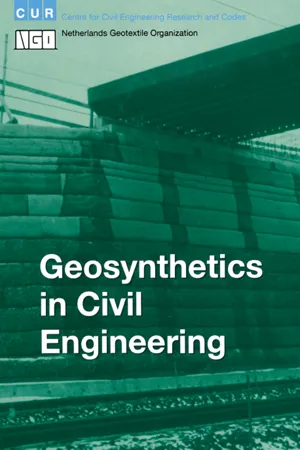
This is a test
- 116 pages
- English
- ePUB (mobile friendly)
- Available on iOS & Android
eBook - ePub
Geosynthetics in Civil Engineering
Book details
Book preview
Table of contents
Citations
About This Book
This handbook provides an introduction to the application possibilities of geosynthetics as building material, covering soil structures, foundations engineering and bank and bed protection. The text covers general design considerations and elaborated examples.
Frequently asked questions
At the moment all of our mobile-responsive ePub books are available to download via the app. Most of our PDFs are also available to download and we're working on making the final remaining ones downloadable now. Learn more here.
Both plans give you full access to the library and all of Perlego’s features. The only differences are the price and subscription period: With the annual plan you’ll save around 30% compared to 12 months on the monthly plan.
We are an online textbook subscription service, where you can get access to an entire online library for less than the price of a single book per month. With over 1 million books across 1000+ topics, we’ve got you covered! Learn more here.
Look out for the read-aloud symbol on your next book to see if you can listen to it. The read-aloud tool reads text aloud for you, highlighting the text as it is being read. You can pause it, speed it up and slow it down. Learn more here.
Yes, you can access Geosynthetics in Civil Engineering by G.P.T.M.van Santvoort in PDF and/or ePUB format, as well as other popular books in Technology & Engineering & Civil Engineering. We have over one million books available in our catalogue for you to explore.
Information
CHAPTER 1
Introduction
1.1 Objective and target group
In the past 25 years many applications of geosynthetics have proved their value in civil engineering projects. To meet the demand for knowledge concerning geosynthetics, a comprehensive manual has been published in 1986 called ‘Geotextiles and Geomembranes in Civil Engineering’. This book was revised in early 1994.
For students at Technical Colleges there appeared to be a demand for an easy to read and to consult, concise handbook. This handbook offers students in civil engineering, environmental technics and land development the subject matter necessary for an orientation on the application possibilities of geosynthetics as building material. The presented general knowledge of geosynthetics may also be of value for officials from Authorities, Consulting Engineering firms, Contractors and the Supply Industry concerned. All those who like to widen their knowledge in theoretical aspects are referred to the above mentioned comprehensive manual and to the publications mentioned in the literature list of this book.
This book deals with the application of geosynthetics in soil structures, foundations engineering and bank- and bed protection. The application of geosynthetics for other civil engineering purposes is mentioned only obliquely, like asphalt reinforcement and drainage of embankments.
Besides, it has to be mentioned that the application possibilities of geosynthetics is still developing. In this book the state of the art of the mid-nineties is presented.
1.2 Framework of the book
It is assumed that students command the basic knowledge of geotechnics and hydraulics. The book is in three parts:
The first part ‘General’, with the Chapters 2 and 3, forms a complete whole. It contains the elementary knowledge of geosynthetics every civil student should know.
Part two ‘Design Considerations’ is an elaboration of Part one and is concentrated on applications of geosynthetics in civil engineering practice. The lecturer may make a choice out of the Chapters 4, 5 and 6, in which the three most important functional applications are presented, respectively: reinforcement, filter/ separation and screen.
Each chapter starts with the characteristic material properties which are of functional importance for the applications discussed. Thereafter design considerations are presented, followed by a section concerning remaining aspects. Because these aspects refer to functional applications, they are presented in Chapters 7 and 8 again in a well-ordered and comprehensive way.
In part three, ‘Elaborated Examples’, three structural designs are elaborated in detail with calculation examples. The Chapters 9, 10 and 11 are related to, respectively, the Chapters 4, 5 and 6.
CHAPTER 2
Examples
2.1 Introduction
For a quick orientation and introduction on application possibilities of geosynthetics eight typical examples are presented in the following section. The first three examples concern soil reinforcement, the next two a filter or separation layer and the last three an impermeable screen.
With each example a picture and a figure of an application is shown and the main functions of the geosynthetic are mentioned. For the meaning of the given numbers one is referred to the corresponding, larger drawing given with the in Section 3.4 elaborated examples.
2.2 Examples
Example 1: Reinforcement 1.

Figure 2.1. Embankment on a natural ground with low bearing capacity; polyester fabric.
Example 2: Reinforcement 2.
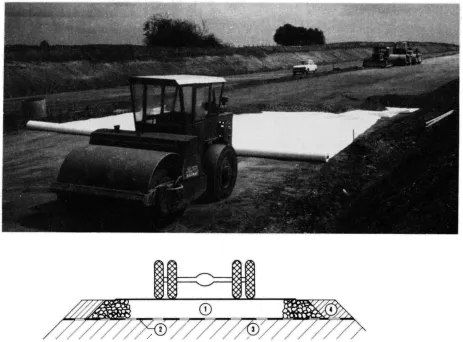
Figure 2.2. Road foundation on a natural ground with low bearing capacity; polyester fabric.
Example 3: Reinforcement 3.

Figure 2.3. Steep slope structure; polyester fabric.
Example 4: Filter 1.
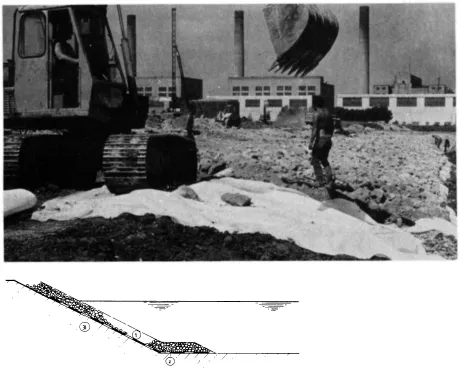
Figure 2.4. River bank protection with a filter construction and a riprap revetment; polypropylene, polyethylene or polyester fabric or nonwoven.
Example 5: Filter 2.
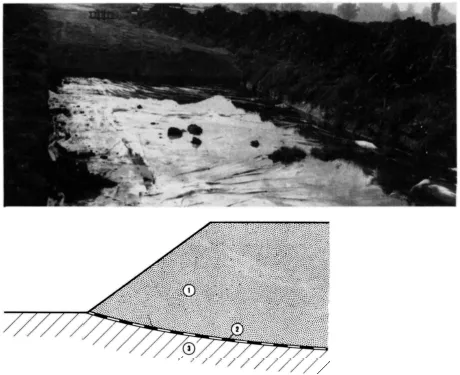
Figure 2.5. Separation of embankment and natural ground; polyester, polyethylene or polypropylene nonwoven.
Example 6: Screen 1.

Figure 2.6. Sealing of a reservoir; polyethylene membrane.
Example 7: Screen 2.
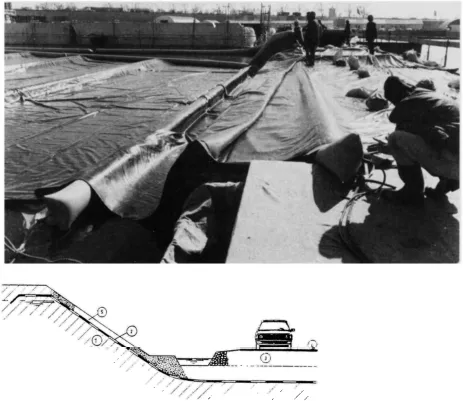
Figure 2.7. Road in cutting below water table; polyethylene or polyvinylchloride membrane.
Example 8: Screen 3.
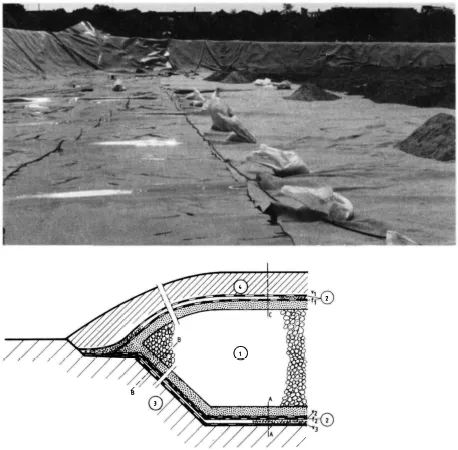
Figure 2.8. Landfill; polyethylene membrane; protecting nonwovens of polyester or polypropylene.
Examples of other applications used in construction and civil engineering
Geosynthetics are used for many purposes and in a large variety of forms which are not the subject of this book. Some examples are:
Vertical drains:
– For acceleration of the consolidation and consequently the settlement of embankments.
– For the run-off of water along structures.
Horizontal drains:
– For the acceleration of the discharge of free water in soil structures.
Inlays in road pavements:
– To decelerate reflective cracking.
– As reinforcement of an asphaltic layer.
– As carrier for a wearing course.
Temporary boardings:
– To let cure cement-bound materials in a certain shape.
Containers:
– Gabions units for hydraulic structures filled with granular material.
Honeycomb structures:
– Open cellular structures filled with granular material, creating rigid revetments to prevent erosion on banks.
Pictures of some of these applications have been placed all through the book.
2.3 Summary
Eight characteristic examples are presented of applications of geosynthetics in civil engineering practice. The examples are functionally clustered.
Reinforcement:
– Embankment on a natural ground with low bearing capacity.
– Road foundation on a natural ground with low bearing capacity.
– Steep slope structure.
Filter:
– Bank protection with a filter construction.
– Separation of embankment and natural ground.
Screen:
– Sealing of a reservoir.
– Road in cutting below water table.
– Landfill.
Other functional applications are not a subject of this book.
CHAPTER 3
Properties and functional applications
3.1 Introduction
Geosynthetics are used for several purposes in civil engineering, especially as reinforcement, as filter or separation layer, or...
Table of contents
- Cover
- Half Title
- Title Page
- Copyright Page
- Table of Contents
- PREFACE
- LIST OF SYMBOLS
- 1 INTRODUCTION
- PART 1: GENERAL
- PART 2: DESIGN CONSIDERATIONS
- PART 3: ELABORATED EXAMPLES
- LITERATURE